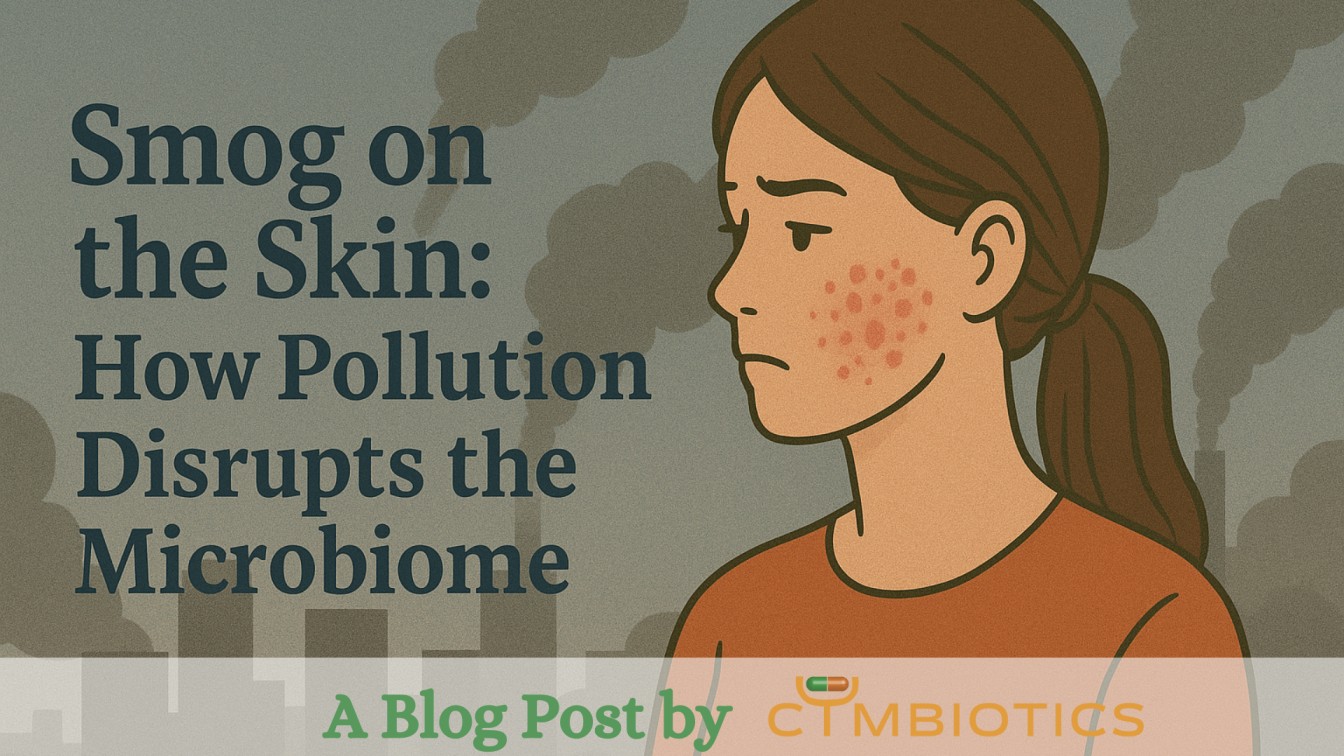Urban life comes with undeniable benefits, but also invisible costs. One of the most overlooked is how environmental pollutants interact with the skin, not just on its surface but within its living ecosystem: the microbiome. The microbiome is home to billions of microorganisms, bacteria, fungi, and viruses that work with the skin to defend against pathogens, regulate immune activity, and maintain barrier health. When air pollution disrupts this balance, the consequences reach far beyond the surface.
The Skin Microbiome: A Protective Ecosystem
The skin microbiome functions as a natural shield. Beneficial microbes occupy niches that might otherwise be taken up by pathogens, produce antimicrobial peptides, and communicate with the immune system to fine-tune inflammatory responses. A healthy microbiome supports hydration, barrier integrity, and tolerance to environmental stress. Disruption of this delicate equilibrium, called dysbiosis has been linked to acne, atopic eczema, seborrheic dermatitis, and accelerated skin aging.
Pollution: A Silent Aggressor
Airborne pollutants include particulate matter (PM2.5 and PM10), nitrogen oxides, sulfur dioxide, polycyclic aromatic hydrocarbons (PAHs), and ozone. These particles adhere to the skin’s surface, penetrating through hair follicles or microfissures in the barrier.
Pollutants generate oxidative stress, producing reactive oxygen species (ROS) that damage skin lipids, proteins, and DNA. But their influence doesn’t stop at structural damage, they also alter the composition of the skin microbiome. By shifting microbial diversity and encouraging the overgrowth of pathogenic organisms, pollution promotes chronic low-grade inflammation and barrier instability.
Microbiome and Dysbiosis in Polluted Environments
Studies show that high pollution exposure reduces microbial diversity and favors bacteria associated with inflammation. For example, dysbiosis has been observed in urban dwellers with higher levels of Cutibacterium acnes variants linked to acne, or increased colonization by Staphylococcus aureus, often associated with eczema.
Pollution-driven dysbiosis contributes to:
- Acne flare-ups through sebum oxidation and pore colonization.
- Atopic eczema aggravation by promoting pathogenic bacteria over beneficial commensals.
- Premature aging as altered microbes exacerbate oxidative stress and inflammatory signaling.
This highlights how pollution doesn’t simply damage the skin barrier, it reshapes its living microbial ecosystem.
Beyond Cleansing: Building Defense
Daily cleansing can remove some pollutants, but it cannot undo oxidative stress or restore microbial balance. Advanced approaches emphasize barrier reinforcement, antioxidant delivery, and microbiome-supportive strategies. By supporting microbial diversity rather than indiscriminately stripping the skin, formulations can help restore the balance disrupted by urban pollutants.
Cymbiotics’ Perspective: Respecting the Microbiome in a Polluted World
At Cymbiotics, innovation is guided by the understanding that skin is not just a barrier, but an ecosystem. Pollution challenges both the barrier and the microbiome, demanding solutions that go deeper than surface cleansing.
Our mission is to enhance health and well-being through continuous innovation and the delivery of science-backed formulations. By pioneering dermal technologies like Cetosomes™ and FADD™ (Fast Acting Dermal Delivery), Cymbiotics advances delivery systems that optimize hydration, strengthen barrier integrity, and respect microbial balance.
Protecting skin in a polluted environment requires not just shielding it from particles, but supporting the microbial life that defends it. Cymbiotics remains committed to developing dermal innovations that work in harmony with the skin’s ecosystem to ensure long-term resilience.
References
- “Impact of Water Exposure and Temperature Changes on Skin Barrier Function” – Pischel S, Fölster-Holst R, Proksch E, International Journal of Environmental Research and Public Health, 2022.
- “Transepidermal water loss (TEWL): Environment and pollution — A review” – Rodrigues LM, Mota C, Massa A, Alves L, Skin Research and Technology, 2022.
- “Influence of Accumulation of Humidity under Wound Dressings and Effects on Transepidermal Water Loss (TEWL) and Skin Hydration” – Kottner J, Dobos G, Lahmann N, Applied Sciences, 2022.
- “Tinea versicolor: an updated review” – Leung AKC, Barankin B, Journal of Fungi, 2022.
- “Forgotten Fungi: The Importance of the Skin Mycobiome” – Nguyen KD, Oh J, Wang J, Microorganisms, 2022.
- “A Review of Advancement on Influencing Factors of Acne” – Yang J, Cheng B, Li S, Journal of Clinical and Aesthetic Dermatology, 2020.
- “Challenges in exploring and manipulating the human skin microbiome” – Boxberger M, Cenizo V, Cassir N, La Scola B, Microbiome, 2021.


